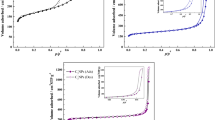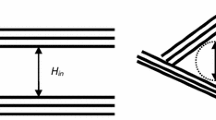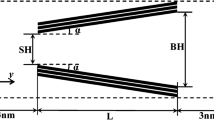Abstract
For porous carbons, which typically have hierarchical structures, the pore size distribution (PSD) is one of the most important characteristics and is currently evaluated by using kernel fitting methods represented by non-local density functional theory. Herein, we present new kernels for N\(_{2}\) and Ar adsorption at 77 K and 87 K, respectively, derived from Monte Carlo (MC) simulations based on a carbon slit-pore model that considers energetic heterogeneity due to surface roughness. The model consists of a locally scaled Lennard–Jones (LJ) 10-4 potential and Steele’s 10-4-3 potential, and the scaling factors of the LJ 10-4 potential are assumed to follow a normal distribution that mimics the adsorption behavior on real carbon black. In contrast to our previous MC kernel based on Steele’s 10-4-3 potential, the local isotherms of the new kernel did not show a steep increase due to adsorption layer formation. Despite the improved fit for adsorption isotherms, PSDs obtained from the proposed kernel unfortunately show a non-negligible valley around 1 nm, which is a major artifact of the kernel fitting approach. A careful comparison of the smooth and rough surface models indicated that the definitive cause of the artifact lies not in the formation of monolayers, which was believed so far, but rather in the pore-filling behavior, which provides a major clue for constructing a completely artifact-free kernel based on molecular simulations.
Graphical abstract









Similar content being viewed by others
Availability of data and materials
The data that support the findings of this study are available from the corresponding authors upon reasonable request.
References
Bhatia, S.K.: Characterizing structural complexity in disordered carbons: From the slit pore to atomistic models. Langmuir 33(4), 831–847 (2017). https://doi.org/10.1021/acs.langmuir.6b03459
Chenoweth, K., van Duin, A.C.T., Goddard, W.A.: Reaxff reactive force field for molecular dynamics simulations of hydrocarbon oxidation. J. Phys. Chem. A 112(5), 1040–1053 (2008). https://doi.org/10.1021/jp709896w
Chihara, K., Suzuki, M.: Control of micropore diffusivities of molecular sieving carbon by deposition of hydrocarbons. Carbon 17(4), 339–343 (1979). https://doi.org/10.1016/0008-6223(79)90006-X
Dollimore, D., Heal, G.R.: An improved method for the calculation of pore size distribution from adsorption data. J. Appl. Chem. 14(3), 109–114 (1964). https://doi.org/10.1002/jctb.5010140302
Errington, J.R.: Direct calculation of liquid-vapor phase equilibria from transition matrix monte carlo simulation. J. Chem. Phys. 118(22), 9915–9925 (2003)
Evans, R., Tarazona, P.: Theory of condensation in narrow capillaries. Phys. Rev. Lett. 52(7), 557–560 (1984). https://doi.org/10.1103/PhysRevLett.52.557
Evans, R., Marconi, U.M.B., Tarazona, P.: Capillary condensation and adsorption in cylindrical and slit-like pores. J. Chem. Soc .Faraday Trans. Mol. Chem. Phys. 82(10), 1763–1787 (1986). https://doi.org/10.1039/F29868201763
Evans, R., Marconi, U.M.B., Tarazona, P.: Fluids in narrow pores: Adsorption, capillary condensation, and critical points. J. Chem. Phys. 84(4), 2376–2399 (1986). https://doi.org/10.1063/1.450352
Gauden, P.A., Terzyk, A.P., Kowalczyk, P.: Some remarks on the calculation of the pore size distribution function of activated carbons. J. Colloid Interface Sci. 300(2), 453–474 (2006). https://doi.org/10.1016/j.jcis.2006.04.017
Horvath, G., Kawazoe, K.: Method for the calculation of effective pore size distribution in molecular sieve carbon. J. Chem. Eng. Jpn 16(6), 470–475 (1983). https://doi.org/10.1252/jcej.16.470
Ishida, M., Ohba, T.: Hybrid reverse molecular dynamics simulation as new approach to determination of carbon nanostructure of carbon blacks. Sci. Rep. 10(1), 3622 (2020). https://doi.org/10.1038/s41598-020-60372-0
Jagiello, J., Olivier, J.P.: A simple two-dimensional nldft model of gas adsorption in finite carbon pores application to pore structure analysis. J. Phys. Chem. C 113(45), 19382–19385 (2009). https://doi.org/10.1021/jp9082147
Jagiello, J., Olivier, J.P.: 2d-nldft adsorption models for carbon slit-shaped pores with surface energetical heterogeneity and geometrical corrugation. Carbon 55, 70–80 (2013). https://doi.org/10.1016/j.carbon.2012.12.011
Lastoskie, C., Gubbins, K.E., Quirke, N.: Pore size distribution analysis of microporous carbons: a density functional theory approach. J. Phys. Chem. 97(18), 4786–4796 (1993). https://doi.org/10.1021/j100120a035
Lee, J., Kim, J., Hyeon, T.: Recent progress in the synthesis of porous carbon materials. Adv. Mater. 18(16), 2073–2094 (2006). https://doi.org/10.1002/adma.200501576
Liu, B., Shioyama, H., Akita, T., et al.: Metal-organic framework as a template for porous carbon synthesis. J. Am. Chem. Soc. 130(16), 5390–5391 (2008). https://doi.org/10.1021/ja7106146
Loi, Q.K., Prasetyo, L., Tan, J., et al.: Wedge pore modelling of gas adsorption in activated carbon: Consistent pore size distributions. Carbon 166, 414–426 (2020). https://doi.org/10.1016/j.carbon.2020.05.035
Lucena, S.M.P., Paiva, C.A.S., Silvino, P.F.G., et al.: The effect of heterogeneity in the randomly etched graphite model for carbon pore size characterization. Carbon 48(9), 2554–2565 (2010). https://doi.org/10.1016/j.carbon.2010.03.034
Lucena, S.M.P., Oliveira, J.C.A., Gonçalves, D.V., et al.: Second-generation kernel for characterization of carbonaceous material by adsorption. Carbon 119, 378–385 (2017). https://doi.org/10.1016/j.carbon.2017.04.061
Lucena, S.M.P., Gonçalves, R.V., Silvino, P.F.G., et al.: Fingerprints of heterogeneities from carbon oxidative process: a reactive molecular dynamics study. Microporous Mesoporous Mater. 304, 109061 (2020). https://doi.org/10.1016/j.micromeso.2018.07.051
Lucena, S.M.P., Oliveira, J.C.A., Gonçalves, D.V., et al.: Pore size analysis of carbons with heterogeneous kernels from reactive molecular dynamics model and quenched solid density functional theory. Carbon 183, 672–684 (2021). https://doi.org/10.1016/j.carbon.2021.07.059
Miyahara, M.T., Tanaka, H.: Determination of phase equilibria in confined systems by open pore cell monte carlo method. J. Chem. Phys. 138(8), 084709 (2013). https://doi.org/10.1063/1.4792715
Miyahara, M.T., Numaguchi, R., Hiratsuka, T., et al.: Fluids in nanospaces: Molecular simulation studies to find out key mechanisms for engineering. Adsorption 20(2), 213–223 (2014). https://doi.org/10.1007/s10450-013-9588-2
Mohamed, A.R., Mohammadi, M., Darzi, G.N.: Preparation of carbon molecular sieve from lignocellulosic biomass: A review. Renew. Sustain. Energy Rev. 14(6), 1591–1599 (2010). https://doi.org/10.1016/j.rser.2010.01.024
Neimark, A.V., Vishnyakov, A.: Gauge cell method for simulation studies of phase transitions in confined systems. Phys. Rev. E 62(4), 4611–4622 (2000). https://doi.org/10.1103/PhysRevE.62.4611
Neimark, A.V., Ravikovitch, P.I., Grün, M., et al.: Pore size analysis of mcm-41 type adsorbents by means of nitrogen and argon adsorption. J. Colloid Interface Sci. 207(1), 159–169 (1998). https://doi.org/10.1006/jcis.1998.5748
Neimark, A.V., Lin, Y., Ravikovitch, P.I., et al.: Quenched solid density functional theory and pore size analysis of micro-mesoporous carbons. Carbon 47(7), 1617–1628 (2009). https://doi.org/10.1016/j.carbon.2009.01.050
Nguyen, C., Do, D.D.: A New Method for the Characterization Of Porous Materials. Langmuir 15(10), 3608–3615 (1999). https://doi.org/10.1021/la981140d
Nguyen, T.X., Cohaut, N., Bae, J.S., et al.: New method for atomistic modeling of the microstructure of activated carbons using hybrid reverse monte carlo simulation. Langmuir 24(15), 7912–7922 (2008). https://doi.org/10.1021/la800351d
Nishihara, H., Kyotani, T.: Templated nanocarbons for energy storage. Adv. Mater. 24(33), 4473–4498 (2012). https://doi.org/10.1002/adma.201201715
Nishihara, H., Yang, Q.H., Hou, P.X., et al.: A possible buckybowl-like structure of zeolite templated carbon. Carbon 47(5), 1220–1230 (2009). https://doi.org/10.1016/j.carbon.2008.12.040
Alexandre de Oliveira, J.C., Soares Maia, D.A., Toso, J.P., et al.: Characterization of the psd of activated carbons by a heterogeneous surface mixed model. Colloids Surf. A 437, 69–75 (2013). https://doi.org/10.1016/j.colsurfa.2012.11.023
Olivier, J.P., Conklin, W.B.: Mv, Szombathely: Determination of pore size distribution from density functional theory: A comparison of nitrogen and argon results. Stud. Surf. Sci. Catal. 87, 81–89 (1994). https://doi.org/10.1016/S0167-2991(08)63067-0
Opletal, G., Petersen, T.C., Snook, I.K., et al.: Hrmc 2.0: Hybrid reverse monte carlo method with silicon, carbon and germanium potentials. Comput. Phys. Commun. 184(8), 1946–1957 (2013). https://doi.org/10.1016/j.cpc.2013.03.004
Palmer, J.C., Brennan, J.K., Hurley, M.M., et al.: Detailed structural models for activated carbons from molecular simulation. Carbon 47(12), 2904–2913 (2009). https://doi.org/10.1016/j.carbon.2009.06.037
Peterson, B.K., Gubbins, K.E.: Phase transitions in a cylindrical pore. Mol. Phys. 62(1), 215–226 (1987). https://doi.org/10.1080/00268978700102151
Ravikovitch, P.I., Neimark, A.V.: Density functional theory model of adsorption on amorphous and microporous silica materials. Langmuir 22(26), 11171–11179 (2006). https://doi.org/10.1021/la0616146
Ravikovitch, P.I., Vishnyakov, A., Russo, R., et al.: Unified approach to pore size characterization of microporous carbonaceous materials from n2, ar, and co2 adsorption isotherms. Langmuir 16(5), 2311–2320 (2000). https://doi.org/10.1021/la991011c
Seaton, N.A., Walton, J.P.R.B.: A new analysis method for the determination of the pore size distribution of porous carbons from nitrogen adsorption measurements. Carbon 27(6), 853–861 (1989). https://doi.org/10.1016/0008-6223(89)90035-3
Srinivasan, S.G., van Duin, A.C.T., Ganesh, P.: Development of a reaxff potential for carbon condensed phases and its application to the thermal fragmentation of a large fullerene. J. Phys. Chem. A 119(4), 571–580 (2015). https://doi.org/10.1021/jp510274e
Stein, A., Wang, Z., Fierke, M.A.: Functionalization of porous carbon materials with designed pore architecture. Adv. Mater. 21(3), 265–293 (2009). https://doi.org/10.1002/adma.200801492
Tarazona, P.: Free-energy density functional for hard spheres. Phys. Rev. A 31(4), 2672–2679 (1985). https://doi.org/10.1103/PhysRevA.31.2672
Thommes, M., Kaneko, K., Neimark Alexander, V., et al.: Physisorption of gases, with special reference to the evaluation of surface area and pore size distribution (iupac technical report). Pure Appl Chem 87(9–10), 1051 (2015). https://doi.org/10.1515/pac-2014-1117, https://www.degruyter.com/view/j/pac.2015.87.issue-9-10/pac-2014-1117/pac-2014-1117.xml
Tian, W., Zhang, H., Duan, X., et al.: Porous carbons: Structure-oriented design and versatile applications. Adv. Funct. Mater. 30(17), 1909265 (2020). https://doi.org/10.1002/adfm.201909265
Widom, B.: Some topics in the theory of fluids. J. Chem. Phys. 39(11), 2808–2812 (1963). https://doi.org/10.1063/1.1734110
Yamane, Y., Tanaka, H., Miyahara, M.T.: In silico synthesis of carbon molecular sieves for high-performance air separation. Carbon 141, 626–634 (2019). https://doi.org/10.1016/j.carbon.2018.10.021, https://www.sciencedirect.com/science/article/pii/S0008622318309369
Yoon, K., Rahnamoun, A., Swett, J.L., et al.: Atomistic-scale simulations of defect formation in graphene under noble gas ion irradiation. ACS Nano 10(9), 8376–8384 (2016). https://doi.org/10.1021/acsnano.6b03036
Yu, F., Bai, X., Liang, M., et al.: Recent progress on metal-organic framework-derived porous carbon and its composite for pollutant adsorption from liquid phase. Chem Eng J 405, 126960 (2021). https://doi.org/10.1016/j.cej.2020.126960, https://www.sciencedirect.com/science/article/pii/S1385894720330886
Acknowledgements
The authors are grateful to Mr. Funahashi for his assistance in this work. This study was financially supported by a Grant-in-Aid for Challenging Research (Pioneering) no. 21K18187 and a Grant-in-Aid for Scientific Research no. 22H01848.
Funding
This work was supported by a Grant-in-Aid for Challenging Research (Pioneering) no. 21K18187 and a Grant-in-Aid for Scientific Research no. 22H01848.
Author information
Authors and Affiliations
Contributions
SH, MTM, and SW designed this study. SH wrote the paper. HT, SH, and KY wrote the program code. KY and SH performed the molecular simulations. KN measured the experimental data. All authors discussed the results and commented on the manuscript.
Corresponding authors
Ethics declarations
Conflict of interest
The authors declare no competing interests.
Ethical approval
Not applicable.
Additional information
Publisher's Note
Springer Nature remains neutral with regard to jurisdictional claims in published maps and institutional affiliations.
Rights and permissions
Springer Nature or its licensor (e.g. a society or other partner) holds exclusive rights to this article under a publishing agreement with the author(s) or other rightsholder(s); author self-archiving of the accepted manuscript version of this article is solely governed by the terms of such publishing agreement and applicable law.
About this article
Cite this article
Hiraide, S., Yamamoto, K., Tanaka, H. et al. GCMC kernel for analyzing the pore size distribution of porous carbons based on a simplified slit-pore model considering surface energetic heterogeneity. Adsorption 29, 387–399 (2023). https://doi.org/10.1007/s10450-023-00418-7
Received:
Revised:
Accepted:
Published:
Issue Date:
DOI: https://doi.org/10.1007/s10450-023-00418-7




